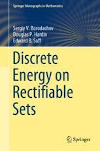- About MAA
- Membership
- MAA Publications
- Periodicals
- Blogs
- MAA Book Series
- MAA Press (an imprint of the AMS)
- MAA Notes
- MAA Reviews
- Mathematical Communication
- Information for Libraries
- Author Resources
- Advertise with MAA
- Meetings
- Competitions
- Programs
- Communities
- MAA Sections
- SIGMAA
- MAA Connect
- Students
- MAA Awards
- Awards Booklets
- Writing Awards
- Teaching Awards
- Service Awards
- Research Awards
- Lecture Awards
- Putnam Competition Individual and Team Winners
- D. E. Shaw Group AMC 8 Awards & Certificates
- Maryam Mirzakhani AMC 10 A Awards & Certificates
- Two Sigma AMC 10 B Awards & Certificates
- Jane Street AMC 12 A Awards & Certificates
- Akamai AMC 12 B Awards & Certificates
- High School Teachers
- News
You are here
Discrete Energy on Rectifiable Sets

Publisher:
Springer
Publication Date:
2019
Number of Pages:
686
Format:
Hardcover
Series:
Springer Monographs in Mathematics
Price:
149.99
ISBN:
978-0-387-84807-5
Category:
Monograph
[Reviewed by , on ]
Jeff Ibbotson
07/4/2021
The book under review is a study of minimal energy problems that are posed for manifolds. In each case a set of discretizations is considered for the manifold in question and global and local minima are sought for an energy function which is generated by a kernel that mimics pairwise interactions of particles. The ideas herein are classical ones but the exploration of these touches many interrelated fields: potential theory, geometry, graph theory, numerical analysis and even coding theory. This book offers both compilations of results and proofs as well as numerical experiments. It is encyclopedic but also fresh – a nice compromise that is achieved through some good writing. The authors are determined not to leave new readers behind at the same time as offering a deep presentation that covers a lot of ground. Who could possibly dislike a text which features beautiful pictures of things like the “poppy-seed bagel theorem”?
An early motivation for the problems under consideration here is the “Thomson problem”: determine the minimal energy (ground state) configurations of N electrons restricted to a sphere in R3 and interacting through the Coulomb potential 1/r. The model which stands behind this is the Plum Pudding Model of the atom in which electrons are arranged in concentric spheres embedded in a positively charged ball. A general solution is unknown except for some special cases. The authors offer a lengthy discussion of this while broadening the potential interactions to Riesz potentials of the form
\( K(x,y)=\frac{1}{| x -y |^{s}}, \; s > 0 \)
as well as the associated logarithmic potential. It is reasonable to expect that the vertices on a regular polyhedron embedded in \( S^{2} \) might minimize the energy due to such potentials but we discover early on that the vertices of a cube or dodecahedron won’t work (they yield results greater than certain square antiprisms!). Surprises such as this become the motivation for a more careful analysis utilizing Hausdorff measures, Lebesgue integration, convexity and types of Fourier analysis. Our intuition for the results on the circle (such as the optimality of the roots of unity) fail to have easy generalizations on the sphere or Torus (or even the lemniscate of Bernoulli) and the investigation broadens to consider best packing and covering inequalities, the asymptotics of each distribution as the number of points approaches infinity and much more. A central question that arises is “how are the minimal s-energy configurations for a compact part of space distributed for large N?” and “is this distribution uniform in configurations close to the optimal one?” Each chapter offers different approaches to the search for optimal configurations and by chapter 5 the authors show how consideration of spherical harmonics and their nodes lead to “kissing numbers” in various dimensions. The transition from the Newton-Gregory problem in 3 dimensions to the 24-cell in 4 dimensions and hence to the \( E_{8} \) lattice in 8 dimensions and finally the Leech lattice in 24 dimensions is simply enthralling and had me on the edge of my seat. The discussion forges ahead and considers zonal equal-area points, generalized spiral points, Fibonacci points, HEALPix nodes, octahedral points, Hammersley nodes and Voronoi decompositions related to each of the above.
As the authors themselves mention in chapter 7 :
“From star-charts to golf ball dimples to testing radar in aircraft, well-placed points on the two- dimensional sphere have a vast number of practical applications”.
The incredible panoply of ideas on display in this book leaves no doubt in the reader's mind of such claims. The authors have done an excellent job at completeness in showcasing the range of techniques one can bring to such a seemingly simple subject. This is a book for every practicing mathematician who is interested in the subject. I am happy it has a place on my bookshelf.
Jeff Ibbotson is the Smith Teaching Chair in Mathematics at Phillips Exeter Academy.
See the publisher's website.
- Log in to post comments




